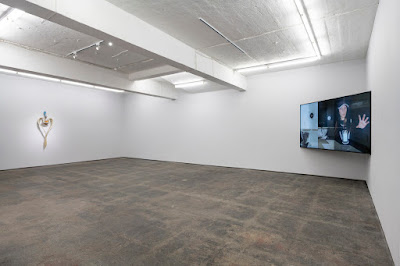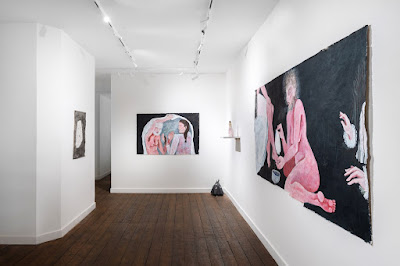In Winter; Mute at Seventeen Gallery
Sensory and mental expectations in the lead up to entering any space can be curious things; whether it is a peripheral buzz, or loud drone, of anxiety when we fear what lies behind the door, or pure excitement, or of course something in between. When it comes to museum or gallery visits, unless you are being taken by a companion, the expectation is usually what sells the experience before you've had it. So what might bring visitors to Seventeen Gallery? Its location in Haggerston in East London may be one, although its entrance is very much hidden down a side street; another might be the calibre of artists, as the current group show 'In winter; mute' boasts work by Nina Davies, Paul B. Davis, Isaac Lythgoe and Lewis Teague-Wright.
Its press release produces an air of mystery around what brings the artists together, and it arguably does take some deeper reading, and looking, to figure it out. The text provided by the gallery does not speak about the exhibition as one singular whole; instead, a thorough introduction to each artist is preceded by an explanation of each artwork. Initially this could be rather frustrating as one tries to navigate the space and create a narrative, but in allowing an understanding of each artwork in relative isolation, the viewer is able to generate ideas about the works singularly and collectively, which is a smart way of devising an exhibition, giving space both to authorship from the respective artists and a freedom of interpretation.
Seventeen Gallery, whilst located in a basement space, is not afflicted with a claustrophobic, nor suffocating, ambience. Having visited several times prior to 'In winter; mute', its lighting always does well to enhance the works presented, whilst inadvertently lifting the mood of the viewer by proxy. The gallery has two neighbouring rooms, and for this exhibition, a significant energy shift and duality separates the two. The first presents a sculptural work by Isaac Lythgoe, a mixed media series by Lewis Teague-Wright and a video piece by Nina Davies.
At first sight, these three works do not seem to have anything obvious in common, but as we have come to expect from the press release, that is not the end-game of Seventeen Gallery. All the mediums are different, and each artist's voice is very different too. It's all rather exciting when it can be seen together in the same space. Isaac Lythgoe's wall-based sculptural work has clear Biblical allusions, with a focal point of two snakes grappling for an apple carved from applewood. Extra information about the works proves incredibly useful, with the insight that the artist "uses ideas from narrative and storytelling traditions to discuss how prospective technologies may influence our future societal structures" not being immediately perspicuous. Taking into account the media used by Lythgoe, including 3D prints, we start to navigate the idea that the binary is not what it perhaps once was; with so much technological and destructive, manmade influence, what is natural? What is synthetic? How authentic are the stories we are being told, and indeed, the ones we tell ourselves?
The pace really seems to change in the back room of the gallery, or perhaps that is the subliminal effect of new media works. Nina Davies' 'Glitch Guiser', a hologram projected through a fan, is utterly transfixing. Pleasingly, the figure, a woman acting out choreographed movements, has been seen in the first room in Davies' 'Never Let Them Know Your First Move' film work. Seventeen's exhibition title might have the viewer thinking about slowness, hibernation and cosiness, but instead we are largely met with fraught anxieties about the issues of today, such as Davies' concerns around "the gig economy and surveillance capitalism", with a practice that investigates "a possible future system of work and governance that commodifies human movement and ultimately supersedes human language". If you are thinking that this seems rather grandiose and ambitious for an exhibition, particularly a group one, you are mostly right, but the ways in which the artist demands attention and draws us in via visual, and social, motifs we recognise such as Amazon warehouses and the gig economy at-large, should be applauded.






